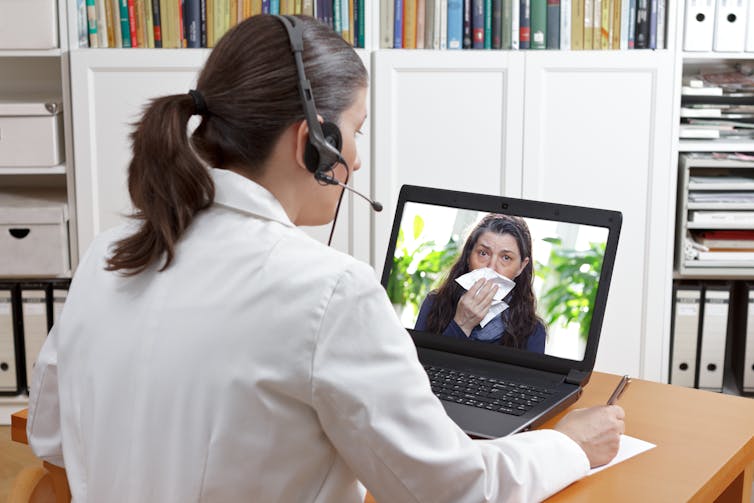Social distancing and lockdowns have disrupted university study for the past 18 months. Students are understandably stressed as shown by a dramatic drop in student satisfaction across Australia reported in the annual Student Experience Survey. Federal Education Minister Alan Tudge has drawn attention to this in calling for a “return” to on-campus study.
But the world is increasingly digital. Old notions of lecture halls will not help graduates to thrive in their careers. We need university study that supports students to succeed by preparing them for a digital future.
Many studies have reported that work will become more blended, with less time spent in the office as working from home increases. The COVID-19 pandemic dramatically accelerated this trend.
Diverse industries have found they can move online effectively, making it an authentic workplace. Telehealth has become the default option for consulting your GP, while the first place to find a service or product is an online search engine. Professionals need to translate their skills into any environment – physical or virtual – and have confidence to use new spaces and formats.

Professionals in the real world, including doctors, must now be prepared to work in a blended environment of online and physical interactions. Shutterstock
What about the impacts on learning?
Learning is created through interactions – with teachers, peers and information. Decades of research show learners learn best when learning is active, engaging, relevant and intentionally designed. Those principles are true wherever the learning happens: on campus, online or in the workplace.
The real question is how to balance the best of online with the best of on-campus and workplace delivery.
Universities are already pursuing this path. University study has been blended for more than two decades as study resources, activities and assessments were moved to subject and course websites in virtual learning environments.
At first, the aim was to organise learning for access anywhere and anytime. Today, digital learning environments have become far more sophisticated. They now also offer tools for group learning, projects and creativity.
‘Emergency remote teaching’ is not the ideal
Online learning during the pandemic was often a compromise. Good learning design takes time as teachers create curriculum, resources and assessment to suit their learners and the discipline. In March 2020, like most Australian universities, academics at my institution, Deakin University, had one week to rebuild our courses to allow our 41,000 on-campus students to keep studying. Of course, many of the activities we had planned became impossible and online substitutes were quickly developed over following weeks.
This global rapid shift was dubbed “emergency remote teaching” by US professor Charles Hodges and colleagues. They warned we should be careful not to judge online learning by this experience.
Good online learning creates a sense of community. It engages students with rich resources and activities. It helps learners to find study buddies and places for their independent work.
However, engagement looks different online. Instead of meeting in a café, students chat online to share ideas and solve problems as they do in their daily lives. Social learning can happen on campus or online.
Some activities work best online, others in person
Some activities should always be online. For a start, contemporary information is digital. Although we enjoy their physical spaces, university libraries are now essentially digital with the vast majority of books, journals and images provided and used online. Data sets, too, are largely digital and analysed with digital tools ranging from spreadsheets to sophisticated software.
Digital learning is great for exploration. The world is at your fingertips, and computers never get tired of practising foundation skills with you.
Other activities need to be in physical space. Using specialist equipment or experiencing a workplace often means being in a purpose-built space. Being in the field develops observation skills and provides more sensory inputs to consider. Collaborating with peers in the same room develops human interaction skills using different social cues from the ones we have online.
Online work can augment these activities with focused preparation and follow-up.
Build on the best of recent experiments
The emergency remote teaching response has pushed teaching teams to consider alternative ways to learn. They have trialled and refined new online activities. Many teachers report they will keep at least some of these.
Professor Eric Mazur at Harvard is famous for his use of peer instruction to make classes active and social. He reports his online model developed during 2020 has improved learning and support so convincingly that he intends to continue with that format. Breaking assumptions about what works best has opened the door to a better understanding of online teaching.
Students in all education sectors have struggled with emergency remote teaching and its backdrop of disrupted life. They have reported difficulties with online provision, lack of motivation, loneliness and decreased mental well-being.

Universities must work to counter the negative impacts on students of emergency remote teaching by refining their online learning offerings. Shutterstock
But universities are refining their courses. When students experience well-designed online learning over time, they build familiarity and confidence. We asked campus-enrolled students at Deakin about their experience of study during the pandemic with regular “pulse-check” surveys. Their feedback shows their confidence in online study and assessment has increased strongly over the past 18 months as they built skills and familiarity.
As we move to more sustainable models for today’s learners, universities are rethinking learning activities. Sitting and listening to the sage on the stage is being replaced by active learning using real-world information and scenarios.
We need to invest in intentional learning design that combines the best of online and on-campus delivery. This will show students they can learn, thrive and build the skills they need however they study.



 Intel’s Testing of China-Linked Chipmaking Tools Raises U.S. National Security Concerns
Intel’s Testing of China-Linked Chipmaking Tools Raises U.S. National Security Concerns  Moore Threads Stock Slides After Risk Warning Despite 600% Surge Since IPO
Moore Threads Stock Slides After Risk Warning Despite 600% Surge Since IPO  Microsoft Unveils Massive Global AI Investments, Prioritizing India’s Rapidly Growing Digital Market
Microsoft Unveils Massive Global AI Investments, Prioritizing India’s Rapidly Growing Digital Market  SpaceX Edges Toward Landmark IPO as Elon Musk Confirms Plans
SpaceX Edges Toward Landmark IPO as Elon Musk Confirms Plans  iRobot Files for Chapter 11 Bankruptcy Amid Rising Competition and Tariff Pressures
iRobot Files for Chapter 11 Bankruptcy Amid Rising Competition and Tariff Pressures  Nvidia Weighs Expanding H200 AI Chip Production as China Demand Surges
Nvidia Weighs Expanding H200 AI Chip Production as China Demand Surges  Trello Outage Disrupts Users as Access Issues Hit Atlassian’s Work Management Platform
Trello Outage Disrupts Users as Access Issues Hit Atlassian’s Work Management Platform  US Charges Two Men in Alleged Nvidia Chip Smuggling Scheme to China
US Charges Two Men in Alleged Nvidia Chip Smuggling Scheme to China  SUPERFORTUNE Launches AI-Powered Mobile App, Expanding Beyond Web3 Into $392 Billion Metaphysics Market
SUPERFORTUNE Launches AI-Powered Mobile App, Expanding Beyond Web3 Into $392 Billion Metaphysics Market  SK Hynix Considers U.S. ADR Listing to Boost Shareholder Value Amid Rising AI Chip Demand
SK Hynix Considers U.S. ADR Listing to Boost Shareholder Value Amid Rising AI Chip Demand  U.S. Greenlights Nvidia H200 Chip Exports to China With 25% Fee
U.S. Greenlights Nvidia H200 Chip Exports to China With 25% Fee  SpaceX Insider Share Sale Values Company Near $800 Billion Amid IPO Speculation
SpaceX Insider Share Sale Values Company Near $800 Billion Amid IPO Speculation  Trump Criticizes EU’s €120 Million Fine on Elon Musk’s X Platform
Trump Criticizes EU’s €120 Million Fine on Elon Musk’s X Platform  China Adds Domestic AI Chips to Government Procurement List as U.S. Considers Easing Nvidia Export Curbs
China Adds Domestic AI Chips to Government Procurement List as U.S. Considers Easing Nvidia Export Curbs  EU Court Cuts Intel Antitrust Fine to €237 Million Amid Long-Running AMD Dispute
EU Court Cuts Intel Antitrust Fine to €237 Million Amid Long-Running AMD Dispute 
































